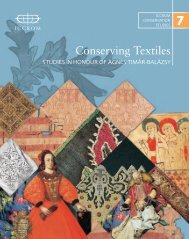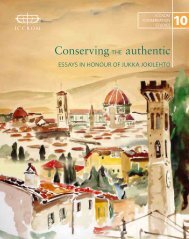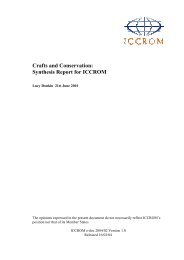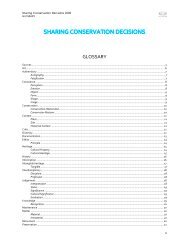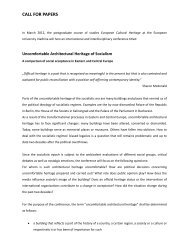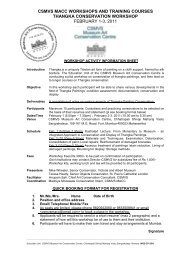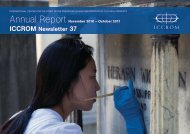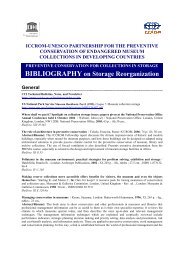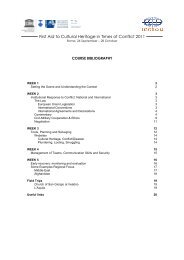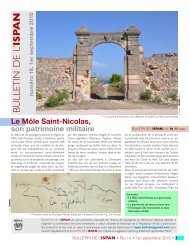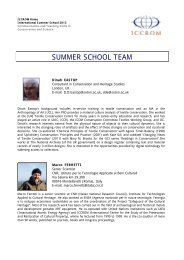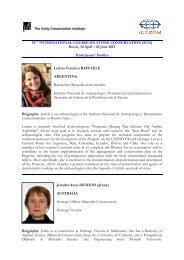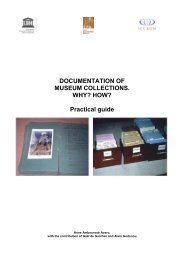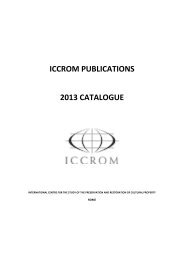part 1 - Iccrom
part 1 - Iccrom
part 1 - Iccrom
You also want an ePaper? Increase the reach of your titles
YUMPU automatically turns print PDFs into web optimized ePapers that Google loves.
MEASURING HERITAGE CONSERVATION PERFORMANCE<br />
6th International Seminar on Urban Conservation<br />
with dealing with these threats later on, first the<br />
threats caused by the (evolving) needs of the local<br />
community of the historic centre of Galle in their<br />
day-to-day pursuits, causing pressure for development,<br />
need to be identified. Moreover, the way in<br />
which these development threats affect the attributes<br />
expressing the OUV will be inventoried.<br />
The second sub-question follows: what are the<br />
development-related threats caused by the evolving<br />
needs of the local community found affecting the<br />
OUV of the historic centre of Galle? What are the<br />
development-related threats? How do they affect<br />
the attributes expressing OUV?<br />
In order to develop the historic centre sustainably,<br />
stakeholders concerned with policy and management<br />
regarding developments within the historic<br />
centre of Galle are responsible for adequate development<br />
strategies which take into account both<br />
conservation of the OUV as well as dealing with<br />
the <strong>part</strong>icular needs of the local community causing<br />
development pressures which pose a threat to the<br />
OUV. Both of these conditions for sustainable development<br />
are discussed above.<br />
Next these stakeholders will be identified and categorized<br />
according to their role in the management<br />
process. It is interesting to understand their roles,<br />
but also the level of communication and cooperation<br />
between them, if any. Furthermore, it is crucial<br />
to understand how these stakeholders manage<br />
developments within the historic centre of Galle<br />
with regard to both the conservation of the OUV as<br />
well as adequately dealing with the threats to the<br />
OUV posed by development needs. In other words,<br />
how far can their current development strategies<br />
be considered sustainable?<br />
This leads to sub-question three: who are the stakeholders<br />
involved in the policy and management<br />
regarding developments within the historic centre<br />
of Galle and what is their current strategy towards<br />
sustainable development? Who are the stakeholders<br />
involved and what are their roles? How do these<br />
stakeholders currently manage conservation of the<br />
OUV as well as deal with development-related<br />
threats?<br />
After the assessment of these inventories using the<br />
cultural significance survey (Pereira Roders, 2007),<br />
justified statements about the adequacy of the current<br />
strategies of the stakeholders involved with the<br />
policies and management regarding developments<br />
can be made. The assessment will also help move<br />
towards simultaneous protection and sustainable<br />
development of the historic centre of Galle, meeting<br />
the evolving needs of the society living within the<br />
walls of the fortification, without representing a loss<br />
of its Outstanding Universal Value for mankind, as<br />
defined by the World Heritage Committee. In the<br />
following section the cultural significance survey<br />
used for the assessment of the inventories will be<br />
elaborated upon.<br />
4. Cultural significance survey<br />
Pereira Roders (2007) states that cultural significance<br />
is multidimensional and argues for the coexistence<br />
of other cultural values than the traditional<br />
historic, aesthetic, scientific and social values to<br />
justify the nomination of a property as cultural heritage.<br />
In addition to the four traditional cultural values<br />
she also distinguishes economic, political, age<br />
and ecological values. The ascription of these eight<br />
values to the inventories form the base for the literature<br />
survey carried out in this research.<br />
As an original contribution on its own, this literature<br />
survey allows stakeholders involved with the<br />
management of the historic centre and its cultural<br />
significance to understand its varied natures and<br />
determine the adequacy of their current strategies,<br />
as well as to define further strategies towards better<br />
protection. Moreover, when complemented<br />
with field surveys and interviews, this survey can<br />
also help by determining where and/or by whom<br />
exactly the cultural significance is being kept alive,<br />
either in the city or by the community.<br />
Systematic analysis of the inventories made to<br />
answer the three sub-questions were made by<br />
coding for the eight above-mentioned cultural<br />
values to make the results comparable and show<br />
discrepancies and/or similarities between the<br />
inventories, not only within the case study, but also<br />
among all of the case studies being carried out in the<br />
global research program. Additionally, the literature<br />
survey allows the identification and categorization<br />
of the attributes expressing the OUV of the property.<br />
These findings will also be complemented with<br />
those from fieldwork and interviews.<br />
5. Preliminary results of<br />
the literature study<br />
Since nomination in 1988, many official documents<br />
have been produced addressing where the cultural<br />
significance of the historic centre of Galle is to be<br />
found. The Advisory Body Evaluation by ICOMOS<br />
and the Nomination File (NF) by the SP have been<br />
Boxem, R.; Fuhren, R.; Pereira Roders, A.; Veldpaus, L.·& B. Colenbrander. 2012. Assessing the cultural significance of World Heritage<br />
cities: the historic centre of Galle as a case study. In Zancheti, S. M. & K. Similä, eds. Measuring heritage conservation performance, pp.<br />
75-81. Rome, ICCROM.<br />
78



